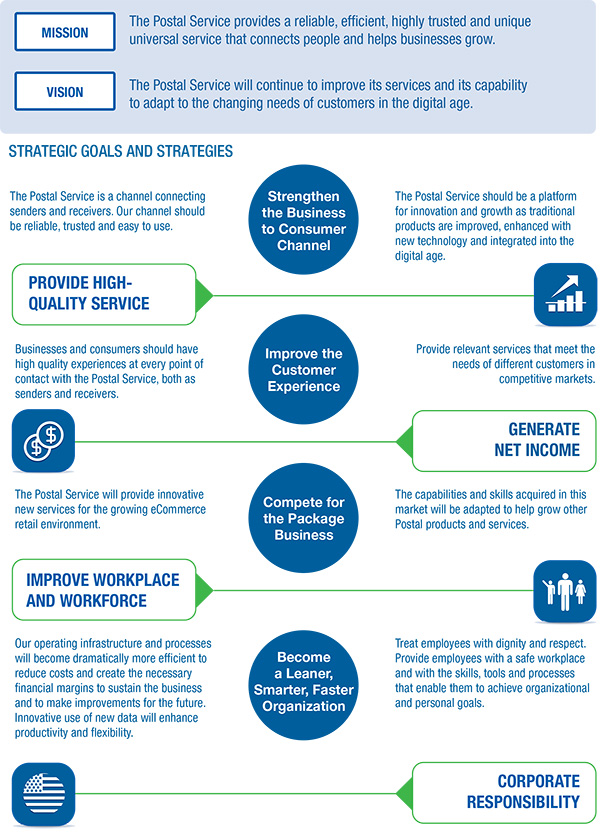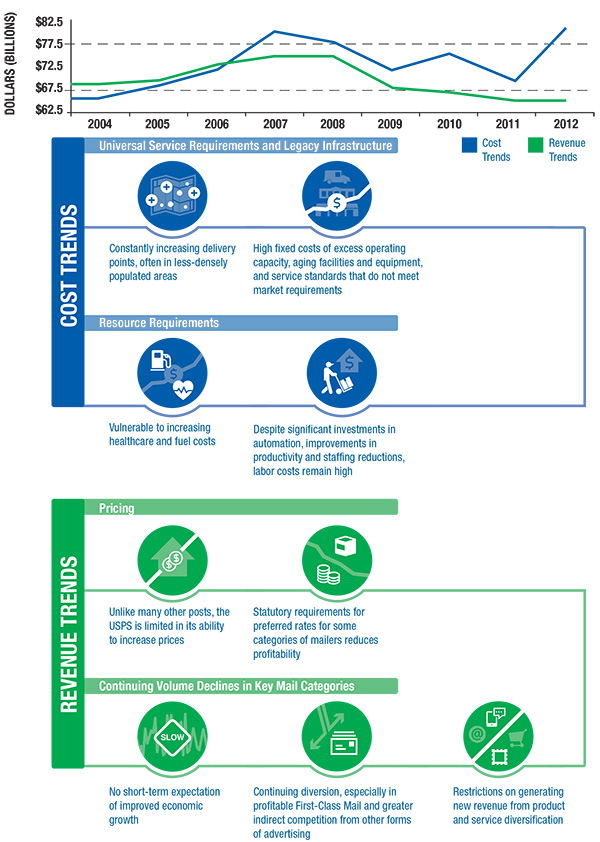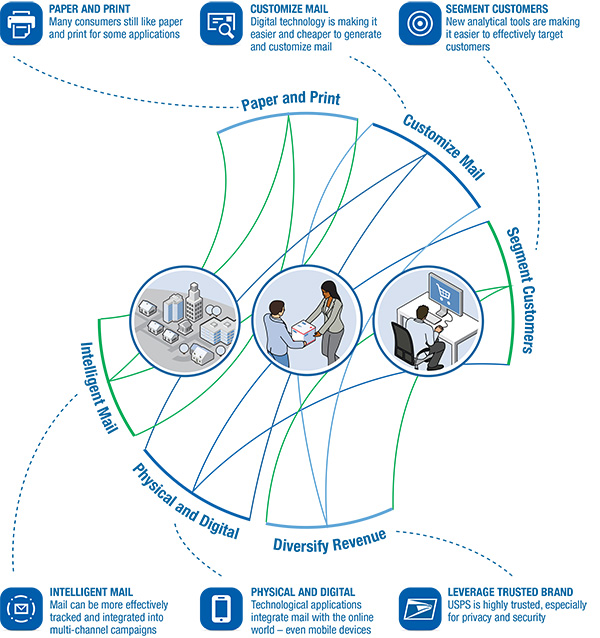Executive Summary
- Postal Facts
- Executive Summary
- Provide Transparency, Accountability and Trust
- Provide Direction for the Future
- Introduction
- The Postal Service is an Adaptable Organization
- Our Mission, Vision, and Goals Remain Relevant
- The Short-Term Business Environment is Challenging
- The Longer-Term Trends Provide Opportunities for Future Success
Provide Transparency, Accountability and Trust
This report provides information to assist stakeholders in evaluating the performance of the Postal Service in 2012.
It combines information required by the Postal Reorganization Act (PRA) of 1970, the Government Performance and Results Act of 1993, and the Postal Accountability and Enhancement Act (PAEA) of 2006 into a single document for convenience and consistency.
Stakeholders should see that:
- The Postal Service is an adaptable and highly capable organization;
- The Postal Service mission, goals and strategies, and vision define its role and value;
- Despite an extremely difficult current financial situation, there are positive longer-term opportunities increasing the value of the Postal Service to customers;
- The Postal Service has a well-developed plan to restore financial stability, and a disciplined process to implement that plan effectively;
- The Postal Service made significant progress on its non-financial goals in FY 2012.
[Return to the top of the page]
Provide Direction for the Future
Although the report is focused on providing performance information for the past year as a supplement to the Annual Report to Congress, the document should also provide stakeholders with information on how Postal initiatives and programs are setting the stage for future improvements.
Stakeholders should see:
- The Postal Service has a portfolio of high priority strategic initiatives that are focused on significant change; and,
- Continuous improvements in daily operations provide the foundation for future successes.
In addition, stakeholders should understand that emerging trends in technology, business and customer behavior can provide scenarios for future opportunities for mail, the mailing industry and the Postal Service to remain relevant in the future.
The document also provides references for more detailed information.
[Return to the top of the page]
Introduction
The Postal Service is an Adaptable Organization
The Postal Service has a long history of successfully adapting to the changing needs of the nation, even as technology has changed the way people communicated and did business.
(See The United States Postal Service: An American History, 1775-2006, http://about.usps.com/publications/pub100/welcome.htm.)
Changing Needs of the Nation

View a description of this graphic
Since the enactment of the Postal Reorganization Act of 1970, the Postal Service has changed its business and operating model, introduced innovative services and focused on productivity and delivery quality.
Postal employees can be proud of the performance of the organization and the progress that has been made. Customers, Postal suppliers and business partners have benefitted from improvements.
The current situation is challenging, but not one that cannot be solved. Innovation and continuous improvements in service and productivity plus collaboration with industry and legislative changes can provide a path to stability as outlined in the Five-Year Business Plan, released in February 2012.
[Return to the top of the page]
Our Mission, Vision and Goals Remain Relevant
Our mission of providing universal delivery service connecting the nation was established in the Constitution. It has been the foundation of Postal policy for 237 years. The vision has always been one of adapting to the changing needs of the nation.
The goals of providing high-quality service, generating net income and improving the workplace have provided consistency in focusing our continuous improvement efforts. The strategic performance metrics are based on these basic goals.
Strategic Goals and Strategies

View a description of this graphic
The core strategies are linked to the mission, vision and goals. They define the focus for change initiatives necessary to respond to the current and future business environment.
The strategies will create a more efficient and effective organization that is more relevant to customers, responsive to the competitive marketplace and more innovative in all it does.
[Return to the top of the page]
The Short-Term Business Environment is Challenging
Even strong organizations are having trouble as a result of the recession and the slow, uneven economic recovery. Most are making significant changes driven by new technology, and rising fuel and healthcare costs.
The short-term financial crisis has captured stakeholder attention and most are aware of the current situation and its causes, and many are aware of some of the cost reduction initiatives our organization has been pursuing.
Business Environment Has Short-Term Challenges and Longer-Term Opportunities

View a description of this graphic
Most successful businesses in this environment have made difficult decisions to remain viable. Postal strategies have emphasized maintaining high levels of delivery service quality and improving customer experiences, even as productivity efforts focused on reducing costs.
The Postal Service has introduced new products and services in the marketplace to grow revenue and improve customer access. The Postal Service has taken extraordinary action to manage its cash to enable it to meet its obligations to customers, employees, partners and suppliers.
[Return to the top of the page]
The Longer-Term Trends Provide Opportunities for Future Success
The long-term trend of declining letter mail volume caused by new communication technology is not restricted to the United States. The issue has attracted studies focusing on the global Postal community and the consensus is that there is no simple solution.
Research indicates that while some mail categories may continue to decline, mail has opportunities to continue to remain relevant. Postal services will still provide a valuable role in the future.
Longer-Term Trends

View a description of this graphic
The unique legislative and regulatory situation of the Postal Service requires approaches that may differ from many foreign posts. However, much of the innovation necessary to adapt the mail to the digital age is already underway, and Postal package services are playing an increasing role in supporting e-commerce.
Entrepreneurs, customers, suppliers and Postal partners in the mailing value chain are creating mail and package services that are more effective at meeting customer needs. Mail is adapting to the digital age, and the Postal Service is evolving to meet the needs of a dynamic market.